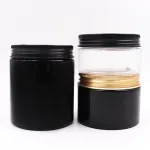Can PET Plastic Be Reused for Food Storage?
In today’s eco-conscious world, reusing materials has become increasingly important, and PET plastic food jars are no exception. Polyethylene terephthalate (PET) is commonly used in water bottles, food containers, and packaging because of its transparency, strength, and recyclability. Understanding the safety, practicality, and environmental benefits of reusing PET is essential for making informed choices about food storage.
The Safety of PET Plastic Food Jar
Chemical Safety
PET is widely recognized as a safe material for food and beverage packaging. Unlike certain plastics, it does not contain bisphenol A (BPA) or phthalates—chemicals often linked to health risks. Regulatory agencies such as the U.S. FDA, Health Canada, and the European Food Safety Authority have approved PET for food contact after thorough testing. These organizations ensure that PET plastic food jars do not release harmful substances into the food or drinks they contain. Its extensive use in the food industry, from bottled water to ready-to-eat meals, further reinforces its safety.
Reusability Concerns
While PET is safe for single use, reusing PET plastic food jars requires care. The primary risk is bacterial contamination rather than chemical leaching. PET itself is chemically stable and does not react with food, but inadequate cleaning can allow bacteria to accumulate. Research shows that reusing PET containers without proper cleaning can pose health risks. Therefore, it is vital to wash containers thoroughly between uses.
Environmental and Practical Benefits
Recyclability
One of the biggest advantages of PET is its high recyclability. PET food jars can be repurposed into new containers, reducing the need for virgin plastic and minimizing environmental impact. The recycling process is well-established globally, and industry data shows PET is the most recycled plastic in the world, with nearly 30% recycled in the United States alone. High recyclability helps reduce plastic waste and conserve natural resources.
Durability and Barrier Properties
PET is valued for its durability and excellent barrier properties, protecting food from moisture, air, and external contaminants. This helps maintain freshness and extend shelf life, making PET plastic food jars ideal for storing a wide range of foods, from snacks to baked goods. PET containers are also less likely to break or degrade under normal use, providing reliable protection for their contents.
Best Practices for Reusing PET Plastic Food Jar
To safely reuse PET containers, consider these guidelines:
Thorough Cleaning
Wash PET plastic food jars with warm, soapy water and let them dry completely before reuse. A bottle brush can help reach all corners to remove any food residue and minimize bacterial risks.
Avoid Heat Exposure
Do not expose PET containers to high temperatures, such as microwaves or hot dishwashers. Heat can warp the plastic and may cause the release of harmful substances, reducing the container’s safety and effectiveness.
Inspect for Damage
Regularly check PET containers for scratches, cracks, or other signs of wear. Damaged PET plastic food jars can harbor bacteria and should be recycled instead of reused.
Conclusion
PET plastic food jars are safe, durable, and environmentally friendly options for food storage when used properly. Their chemical safety, recyclability, and strong barrier properties make them a popular choice in the food industry. By following proper cleaning practices and avoiding exposure to high heat, consumers can confidently reuse PET containers while minimizing health risks. Choosing PET plastic food jars not only protects your food but also supports a more sustainable lifestyle.
- Previous: None
- Next: None
- 0



